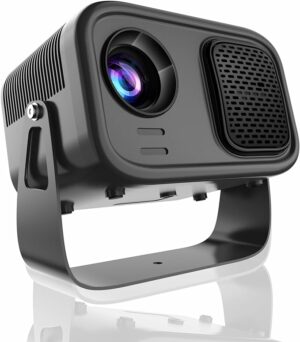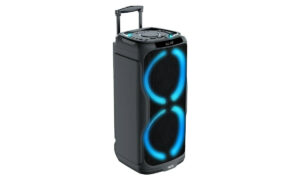
Panasonic apresenta duas novas câmeras Micro Four Thirds; G2 tem controle via touchscreen
A Panasonic anunciou duas novas câmeras Lumix com o sistema Micro Four Thirds: a DMC-G2, com touchscreen móvel, e a DMC-G10, que se destaca pela leveza.
A G2 é a descendente direta da G1, a primeira câmera digital Micro Four Thirds. Ela tem sensor de 12,1 megapixels e grava vídeo a 720p em AVCHD Lite por meio de um botão dedicado para filmagem. Ela é a primeira máquina com lentes intercambiáveis a ter uma touchscreen móvel que pode ser utilizada para controlar a câmera.
A tela de LCD tem três polegadas, 460 mil pontos de resolução e rotação de 180° de lado a lado e 270° de cima a baixo. Toques na tela podem ser usados para ajustar o foco ou simplesmente tirar fotos.
A G2 Será disponibilizada em preto, vermelho e azul.
A G10 é uma máquina mais básica, anunciada pela Panasonic como a “câmera digital com visor e sistema de lentes intercambiáveis mais leve do mundo”. Assim como a G2, tem sensor de 12,1 megapixels e grava vídeo a 720p – mas apenas em Motion JPEG, não em AVCHD Lite. Sua tela de LCD tem três polegadas e 460 mil pontos de resolução, mas não é sensível ao toque, e o visor tem uma definição muito menor do que o da G2.
Tanto a G2 quanto a G10 virão com objetiva Lumix G Vario 14-42mm/F3.5-5.6 (equiv. 35mm 28-84mm) em seus respectivos kits.
Preços e disponibilidade ainda não foram divulgados.
LUMIX DMC-G2, WORLD’S FIRST* INTERCHANGEABLE LENS SYSTEM CAMERA WITH TOUCH-CONTROL MOVABLE LCD
Panasonic LUMIX G2 Features a 3-Inch Touch-Screen, Allowing for Quick and Intuitive Setting Changes, such as Focus, with a Single Touch
Secaucus, NJ (March 7, 2010) – Panasonic today announces the LUMIX DMC-G2, the world’s first* digital interchangeable lens system camera with a movable LCD that allows for touch-control, and the successor to the award-winning and revolutionary LUMIX G1, which was the world’s first Micro Four Thirds digital camera. The intuitive touch-control shooting elevates the camera’s operability, letting the user adjust auto focus (AF) simply by touching the subject on the large 3.0-inch 460,000-dot high- resolution LCD. The LUMIX G2, also shoots 720p High Definition video using the AVCHD Lite format, and joins the LUMIX G10, also introduced today, as the latest models in the LUMIX G Micro System.
With the touch-screen operation, users can even snap a photo by touching the LUMIX G2’s screen. Additionally, the touch-screen operation excels not only for shooting but also during playback. Users can touch one thumbnail viewed among many to quickly and easily see the full size of the desired photo. Also, to view images one-by-one, photos can be dragged across the screen to browse as though flipping the pages of a book.
"With the LUMIX G2, Panasonic is pleased to continue to lead the evolution of the Micro Four Thirds platform and also be the first in the industry to offer a touch-screen interchangeable lens system camera," said David Briganti, Senior Product Manager, Imaging, Panasonic Consumer Electronics Company. "Touch-operation is a user interface with which many consumers are both familiar and expect, and we think the LUMIX G2’s touch-operation makes it easier and quicker to take photos and videos that have professional-like effects."
Using the touch-screen operation, once a user locks onto a subject, the LUMIX G2 enables AF Tracking and will track the subject as it moves within the frame. Then, with a touch on the screen, users can select the part and the size of AF area with the 1-area AF. The Multi-area AF sets a group of AF points according to the composition. While using the manual focus, users can enlarge a subject by touching it and then choosing to enlarge it by 1x, 5x or 10x and then smoothly moving the part by dragging it on the screen. With this touch operation, menu settings can be changed quickly; cutting the time it takes to navigate using standard cursors. However, all setting changes can still be done using the control pad, if preferred.
The LUMIX G2 records 1280 x 720 HD videos in the AVCHD Lite format, which increases recording capacity and is highly compatible with audio-visual equipment. With a dedicated video record button, users can easily start recording a video. To complement its high-quality video capabilities, the LUMIX G2 features advanced audio options, as sound is recorded with Dolby Digital Creator and an optional accessory stereo microphone can be attached. A Wind Cut function further enhances the sound as it helps reduce noise caused from background wind.
The 3.0-inch touch-operation LCD has a wide-viewing angle and rotates 180° from side to side and tilts 270° up and down, providing approximately 100% of field of view. This free-angle LCD with a touch-screen operation makes it possible to both view and touch the screen from any angle. The double Live-View function offered by the high-resolution, 460,000-dot free-angle Intelligent LCD and 1,440,000-dot 1.4x (0.7x) Live View Finder allows users to see the settings’ results before pressing the shutter.
The 12.1-megapixel Live MOS sensor featured in the LUMIX G2 offers the best of both worlds – the outstanding image quality of a CCD sensor, and the lower power consumption of a CMOS sensor. Advanced technology enables it to read four channels of data simultaneously, helping the LUMIX G2 to deliver 60 frames-per-second Full-time Live View images, while faithfully reproducing high-resolution images with fine detail and rich gradation. Plus, with the high-speed, high-performance Venus Engine HD II, which has been re-engineered to further improve image quality.
The new high-speed, high-performance Venus Engine HD II supports the new image processing technology Intelligent Resolution, which enables the recording of beautiful photo and HD video with high quality signal processing. With Intelligent Resolution technology, three areas – outlines, detailed texture areas and soft gradation – are automatically detected. The outline parts are enhanced effectively to give edges increased clarity, while simultaneously giving a moderate accentuation to the textured areas so they look finely detailed. For the soft gradation areas, the improved noise reduction system of the Venus Engine HD II is applied to achieve a smoother effect. Apart from the uniform enhancement of sharpness, the innovative technology Intelligent Resolution precisely performs signal processing pixel by pixel in the most effective way, resulting in images that are naturally clear.
For users looking for additional creative options for both photos and videos, the LUMIX G2 delivers. While shooting HD video, users can set the camera in "P" mode – to change the aperture for professional-like movie effects where the images blur into focus. For still photos, the LUMIX G2 features the My Color mode with a total of seven preset effects – Expressive, Retro, Pure, Elegant, Monochrome, Dynamic Art, and Silhouette while also keeping the Custom mode, which lets users manually set the color, brightness and saturation levels and save their favorite settings into memory.
On the other hand, for beginner users not yet ready for manual modes – the LUMIX G2 features iA (Intelligent Auto), a popular setting in the LUMIX point-and-shoots that automatically engages features and settings for optimal image quality by detecting the shooting environment. Panasonic iA is available in both still photo and video recording settings and a new dedicated iA button, which illuminates in blue when engaged, makes it even easier to use this handy feature.
Other features of the LUMIX G2 include:
• Dust Reduction System: If dust or other foreign matter gets inside the camera when you’re changing lenses, it could cling to the image sensor and show up as a spot in your photos. The Dust Reduction System in the G2 helps eliminate this possibility by placing a supersonic wave filter in front of the Live MOS sensor. Vibrating vertically around 50,000 times per second, the filter repels dust and other particles effectively.
• Included Software: PHOTOfunSTUDIO 5.0 HD Edition makes it possible to sort and organize photos. Videos can be uploaded directly to YouTube using the built-in YouTube uploader – even in HD quality. It also lets you create a 360-degree rotation panorama file in .MOV files. The software is compatible with the Windows 7.The Panasonic LUMIX G2 will come equipped as part of its kit, with the newly announced LUMIX G VARIO 14-42mm/F3.5-5.6 ASPH/MEGA O.I.S. lens. The new lens offers a versatile zoom range of 14-42mm (35mm camera equivalent: 28-84mm), making it suitable for a wide variety of scenes, everything from dynamic landscape to portrait. Additionally, the LUMIX G2 is compatible with all Micro Four Thirds System lenses, allowing users even higher levels of performance in a digital interchangeable lens camera.
The LUMIX DMC-G2 and other LUMIX G Micro System digital cameras can use any interchangeable lens that complies with the Four Thirds standard via an optional mount adaptor DMW-MA1 and with the prestigious Leica M/R Lenses via DMW-MA2M or MA3R. Other accessories include external flashes, filters, a remote shutter, HDMI mini cables and a variety of stylish straps and bags. To learn about the Panasonic LUMIX Micro Four Thirds System and all the available accessories, visit www.panasonic.com/lumix. The Panasonic LUMIX G2 will be available in red, blue and black models and pricing and availability will be announced 30 days prior to shipping date.
PANASONIC LUMIX G10, WORLD’S LIGHTEST* DIGITAL INTERCHANGEABLE LENS SYSTEM CAMERA WITH A VIEWFINDER
Compact and easy-to-use, the LUMIX G10 shoots high-quality photos and HD video and is an approachable alternative for users new to system cameras
Secaucus, NJ (March 7, 2010) – Panasonic today introduces an addition to its Panasonic LUMIX G Series, the LUMIX DMC-G10, the world’s lightest* digital interchangeable lens camera with a viewfinder, which packs a host of advanced digital camera functions designed to be easy-to-use for users new to system cameras. The new compact and portable LUMIX G10, which can record High Definition (HD) video in addition to high-quality still images, joins the LUMIX DMC-G2, also introduced today, as part of the Panasonic LUMIX G Series.
"The LUMIX G Micro System has revolutionized the photography industry ever since the release of the Panasonic G1, the world’s first interchangeable lens system camera based on the Micro Four Thirds System standard," said David Briganti, Senior Product Manager, Imaging, Panasonic Consumer Electronics Company. "We continue to expand this award-winning LUMIX G Series, and with its easy-to-use features and compact size, we expect the G10 to attract a lot of new users who want to step-up from their point-and-shoots."
The LUMIX G10, with its incredible compact body and portable design, uses a mirrorless structure as part the Micro Four Thirds System standard, eliminating a number of components that are found in a conventional interchangeable lens camera, including the mirror box and optical viewfinder unit. This innovative structure allows for the LUMIX G10 to be the world’s lightest system camera in a compact digital camera design that is a desired feature for new users. Adding to its lightweight body, the LUMIX G10 will come equipped as part of its kit, with the newly announced LUMIX G VARIO 14-42mm/F3.5-5.6 ASPH/MEGA O.I.S. lens. The new lens offers a versatile zoom range of 14-42mm (35mm camera equivalent: 28-84mm), making it suitable for shooting a wide-range of scenes, from dynamic landscape to portrait.
Panasonic designed the LUMIX G10 to be easy to use offers iA (Intelligent Auto) mode – with its shooting assist functions that have proven extremely popular in LUMIX compact cameras. Panasonic’s iA (Intelligent Auto), an easy shooting mode with automatic optimization according to the scene in either photo and video recording, is helpful to beginner users unfamiliar with an interchangeable lens system camera. With the new dedicated iA button, which illuminates in blue when engaged, activating this mode is even easier and can be used to shoot both photos and videos.
When shooting still photos, iA offers the following: MEGA O.I.S., which helps prevent blurring from hand-shake; Intelligent ISO Control, which reduces motion blur by adjusting the ISO sensitivity if the subject moves; Intelligent Exposure optimizes exposure for each part of an image, preventing blocked shadows and blown highlights and helping ensure that gradation and details are reproduced properly; Intelligent Scene Selector detects the most common shooting situations – Portrait, Night Portrait, Scenery, Night Scenery, Close-up and Sunset – and switches to the appropriate Scene mode automatically – no setting changes needed.
The LUMIX G10 can record 1280 x 720 HD video in Motion JPEG, QVGA, VGA and WVGA formats. Users can enjoy recording HD videos while taking advantage of the high quality lens and the flexibility to change to other lenses. Even users new to recording videos will find the LUMIX G10 makes it easy. Panasonic’s iA for video offers the following: Optical Image Stabilizer (O.I.S.) helps prevent handshake when using high-powered zoom; Face Detection** automatically detects a face in the frame and adjusts focus, exposure, contrast, and skin complexion; Intelligent Exposure continually checks the ambient light level and adjusts the exposure setting as conditions change to prevent blown highlights and blocked shadows; Intelligent Scene Selector automatically switches between Normal, Portrait, Close-up, Scenery, and Low Light modes according to the situation to optimize visual quality.
With AF Tracking, the LUMIX G10 can lock onto any subject and keep it in focus even if it moves – making it easy to get beautiful, clear shots of moving subjects, such as children and pets. Simply aim, lock, and shoot. The Face Recognition function remembers registered faces to give an appropriate AF/AE on the people. In playback, you can choose to display only photos that contain a specific registered face using Category Playback. The contrast AF system adopted by the LUMIX DMC-G10 is not only accurate and easy to use, but also very fast. Users can choose from a wide range of AF modes, including AF Tracking, 1-area AF, Face Detection AF/AE and 23-area AF.
The LUMIX G10’s Live View Finder, with a resolution of 202,000-dot equivalent, 1.04x (0.52x*) retains the viewability of an optical viewfinder and displays information about its settings that users can see without removing their eye from the subject. The 60 fps Live View is powered by the Live MOS sensor, which takes signals directly from the image sensor and sends them continuously to the LCD, in real time. Both the Live View Finder and LCD provide approximately 100% field of view. This allows the user, when composing a shot, to check the framing accurately from corner to corner. The 3.0-inch large 460,000-dot high-resolution LCD with wide viewing angle automatically controls the brightness according to the situation as an Intelligent LCD.
The 12.1-megapixel Live MOS sensor and the new Venus Engine HD II help to separate chromatic noise from luminance noise and apply the optimal noise reduction to each, so users can capture clear and beautiful images even when shooting at high ISO sensitivity levels. The high-speed, high-performance Venus Engine HD II, which has been re-engineered to incorporate the new image processing technology, Intelligent Resolution, enables the recording of beautiful photo and HD video with high quality signal processing. With Intelligent Resolution technology, three areas – outlines, detailed texture areas and soft gradation –are automatically detected. The outline parts are enhanced effectively to give edges increased clarity, while simultaneously giving a moderate accentuation to the textured areas so they look finely detailed. For the soft gradation areas, the improved noise reduction system of the Venus Engine HD II is applied to achiever a smoother effect. Apart from the uniform enhancement of sharpness, the innovative technology Intelligent Resolution precisely performs signal processing pixel by pixel in the most effective way, resulting in images that are naturally clear.
All Panasonic LUMIX G Series digital cameras are equipped with the highly-efficient Dust Reduction System. If dust or other foreign matter gets inside the LUMIX G10 while changing lenses, it could cling to the image sensor and show up as a spot in your photos. However, with the Dust Reduction System, it helps eliminate this possibility by placing a supersonic wave filter in front of the Live MOS sensor. Vibrating vertically around 50,000 times per second, the filter repels dust and other particles effectively.
Other features of the LUMIX G10 include:
• My Color mode with a total of seven preset effects – Expressive, Retro, Pure, Elegant, Monochrome, Dynamic Art, Silhouette. Also includes Custom mode, which lets users manually set the color, brightness and saturation levels. For beginners, the LUMIX G10’s full-time Live View function lets users see how these settings will affect the images before they shoot, making it easier to capture the exact mood or atmosphere desired.
• Scene modes total 26, including the Peripheral Defocus mode, which lets users take a photo where the foreground is in focus and background is blurred – or vice versa. This popular effect can be intimidating for a beginner, but in the Peripheral Defocus mode, by simply selecting the objects to be blurred and focused using the camera’s keypad, it is simple for photographers of any level.
• Exposure meter can be displayed in the P/A/S/M shooting modes. The correlation between shutter speed and aperture is shown, with a color-coded warning system that alerts users when the settings are not in the proper range. For those new to system camera digital photography, this makes it easy to learn proper settings both visually and logically, enhancing their photography skills.The Panasonic LUMIX G10 is compatible with Micro Four Thirds System lenses, allowing users even higher levels of performance in a digital interchangeable lens camera. In addition to LUMIX G lenses, the LUMIX DMC-G10 and LUMIX G Micro System can use any interchangeable lens that complies with the Four Thirds standard via an optional mount adaptor DMW-MA1 and with the prestigious Leica M/R Lenses via DMW-MA2M or MA3R.
Pricing and availability for the Panasonic LUMIX G10 will be announced 30 days prior to shipping date. It will be available in black. To learn about the Panasonic LUMIX Micro Four Thirds System and all the available accessories, visit www.panasonic.com/lumix.
PANASONIC ANNOUNCES COMPACT AND LIGHTWEIGHT STANDARD ZOOM LENS FOR LUMIX G SERIES DIGITAL CAMERAS
SECAUCUS, NJ (March 7, 2010) – Panasonic today introduces a new interchangeable lens for its LUMIX G Micro System, the ultra-compact and lightweight LUMIX G VARIO 14-42mm/F3.5-5.6 ASPH/MEGA O.I.S. lens offers versatile zoom range of 14-42mm (35mm camera equivalent: 28-84mm), making it suitable for a wide variety of scenes, everything from dynamic landscape to portrait. The LUMIX G VARIO 14-42mm/F3.5-5.6 ASPH/MEGA O.I.S. lens will be part of the kit lens for the latest additions to the LUMIX G Series of digital cameras: the LUMIX DMC-G10 and LUMIX DMC-G2, also introduced today.
The new LUMIX G VARIO 14-42mm/F3.5-5.6 ASPH/MEGA O.I.S. lens incorporates Panasonic’s MEGA O.I.S. (Optical Image Stabilizer), which makes it easy to shoot clear photographs, even in low-lit situations, by suppressing the blur caused by a shaky hand. Adopting an inner-focus system driven by a stepping motor, the superior optical design realizes outstanding smoothness to support the high-speed AF (Auto Focus) system of LUMIX G cameras. When mounted on any of these cameras, this new lens allows users to maximize all of the AF system’s functions.
With its minimum focus distance of 30cm even at full zoom, this lens provides a maximum photographic magnification of 0.32x (35mm equivalent). Seven aperture blades make up a circular aperture diaphragm to produce an attractive smoothness in out-of-focus areas even when shooting at a large aperture. The LUMIX G VARIO 14-42mm/F3.5-5.6 ASPH/MEGA O.I.S. lens system uses multi-coated lens elements that reduce blur, helping to deliver superior performance. This new lens system also features excellent contrast even at its highest zoom level. The inclusion of an aspherical lens improves optical performance by minimizing distortion, even at the 28mm wide end. For more information on the Panasonic LUMIX G Series digital cameras, lenses and accessories, please visit www.panasonic.com/lumix.
























